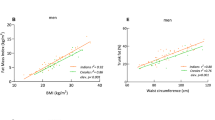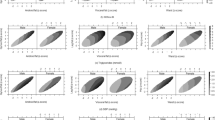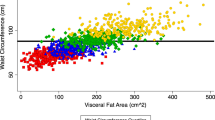Abstract
OBJECTIVE: In the postmenopausal years, women develop a central pattern of fat distribution and an increased risk of developing cardiovascular disease (CVD). The possibility that these events are related has not been extensively investigated. The object of the present study was to test the hypotheses that, 1) menopause-related differences in lipids are associated with greater estimated intra-abdominal adiposity, and 2) the relationship between individual adipose depots and plasma lipids differs with menopausal status.
DESIGN: Cross-sectional.
SUBJECTS: 141 healthy pre- and postmenopausal women aged 35–65 y.
MEASUREMENTS: Total body fat by hydrodensitometry was used as an index of whole-body adiposity, the sum of five central skinfold measurements as an index of subcutaneous upper-body adiposity, and estimated intra-abdominal adipose tissue (IAF) as an index of visceral adiposity. Fasting plasma concentrations of total cholesterol (total-C), high- and low-density-lipoprotein cholesterol (HDL-C, LDL-C), and triglycerides were used as indices of CVD risk.
RESULTS: Postmenopausal women had greater total body fat (P<0.001), summed central skinfolds (P<0.01), estimated IAF (P<0.001), higher plasma concentrations of total-C (P<0.001), LDL-C (P<0.001) and triglycerides (P<0.001), than premenopausal women. The relationship between central skinfolds and LDL-C differed with menopausal status, being significant in pre- but not postmenopausal women. Adjustment for estimated IAF with analysis of covariance decreased menopause-related differences in levels of total-C, LDL-C and triglycerides by approx 40–70%.
CONCLUSION: These observations suggest that, 1) menopause-related changes in IAF may adversely affect the plasma lipid profile, and 2) menopausal status affects the relationship between central subcutaneous fat and LDL-C. Studies with measured IAF are needed to confirm present results.
This is a preview of subscription content, access via your institution
Access options
Subscribe to this journal
Receive 12 print issues and online access
$259.00 per year
only $21.58 per issue
Buy this article
- Purchase on Springer Link
- Instant access to full article PDF
Prices may be subject to local taxes which are calculated during checkout
Similar content being viewed by others
Author information
Authors and Affiliations
Rights and permissions
About this article
Cite this article
Gower, B., Nagy, T., Goran, M. et al. Fat distribution and plasma lipid-lipoprotein concentrations in pre- and postmenopausal women. Int J Obes 22, 605–611 (1998). https://doi.org/10.1038/sj.ijo.0800633
Received:
Revised:
Accepted:
Published:
Issue Date:
DOI: https://doi.org/10.1038/sj.ijo.0800633
Keywords
This article is cited by
-
Measurement of vertebral bone marrow proton density fat fraction in children using quantitative water–fat MRI
Magnetic Resonance Materials in Physics, Biology and Medicine (2017)
-
Relationship between mean platelet volume and low-grade systemic coagulation with vitamin D deficiency in primary ovarian insufficiency
Archives of Gynecology and Obstetrics (2013)
-
Risk Factors for Diabetes Mellitus in Women with Primary Ovarian Insufficiency
Biological Trace Element Research (2013)
-
Impact of body weight and weight loss on cardiovascular risk factors
Current Atherosclerosis Reports (1999)



